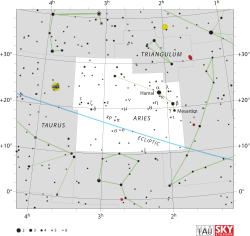Sheratan
| Observation data Epoch J2000 Equinox J2000 |
|
|---|---|
| Constellation | Aries |
| Right ascension | 01h 54m 38.41099s |
| Declination | +20° 48′ 28.9133″ |
| Apparent magnitude (V) | 2.655 |
| Characteristics | |
| Spectral type | A5 V |
| U−B color index | +0.170 |
| B−V color index | +0.142 |
| Astrometry | |
| Radial velocity (Rv) | -1.9 km/s |
| Proper motion (μ) |
RA: +98.74 mas/yr Dec.: -110.41 mas/yr |
| Parallax (π) | 54.74 ± 0.75mas |
| Distance | 59.6 ± 0.8 ly (18.3 ± 0.3 pc) |
| Absolute magnitude (MV) | 1.55 ± 0.09 |
| Orbit | |
| Companion | Beta Arietis B |
| Period (P) | 106.9954 ± 0.0005 days |
| Semi-major axis (a) | 36.1 ± 0.3 mas |
| Eccentricity (e) | 0.903 ± 0.012 |
| Inclination (i) | 44.7 ± 1.3° |
| Longitude of the node (Ω) | 79.1 ± 0.8° |
|
Argument of periastron (ω) (secondary) |
209.1 ± 1.2° |
| Details | |
| A | |
| Mass | 2.34 ± 0.10 M☉ |
| Luminosity | 23 L☉ |
| Surface gravity (log g) | 4.0 cgs |
| Temperature | 9,000 K |
| Metallicity [Fe/H] | 0.16 dex |
| Rotational velocity (v sin i) | 73 km/s |
| Age | 0.3 Gyr |
| B | |
| Mass | 1.34 ± 0.07 M☉ |
| Luminosity | 1.3 L☉ |
| Other designations | |
| Database references | |
| SIMBAD | data |
| ARICNS | data |
Beta Arietis (β Arietis, abbreviated Beta Ari, β Ari), also named Sheratan, is a star in the constellation of Aries, marking the Ram's second horn.
Beta Arietis is the star's Bayer designation. It also bears the Flamsteed designation 6 Arietis.
The traditional name, Sheratan (or Sharatan, Sheratim), in full Al Sharatan, is from the Arabic الشراطان aš-šarāţān "the two signs", a reference to the star having marked the northern vernal equinox together with Gamma Arietis several thousand years ago. In 2016, the International Astronomical Union organized a Working Group on Star Names (WGSN) to catalogue and standardize proper names for stars. The WGSN approved the name Sheratan for this star on 21 August 2016 and it is now so entered in the IAU Catalog of Star Names.
In Chinese, 婁宿 (Lóu Su), meaning Bond (asterism), refers to an asterism consisting of β Arietis, γ Arietis and α Arietis. Consequently, β Arietis itself is known as 婁宿一 (Lóu Su yī, English: the First Star of Bond).
Beta Arietis has an apparent visual magnitude of 2.66. Based on parallax measurements, it is located at a distance of 59.6 light-years (18.3 parsecs) from Earth. This is a spectroscopic binary star system consisting of a pair of stars orbiting around each other with a separation that can not currently be resolved with a conventional telescope. However, the pair have been resolved using the Mark III Stellar Interferometer at the Mount Wilson Observatory. This allows the orbital elements to be computed, as well as the individual masses of the two stars. The stars complete their highly elliptical orbit every 107 days.
...
Wikipedia

